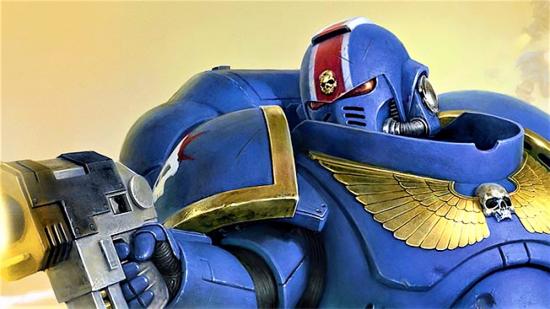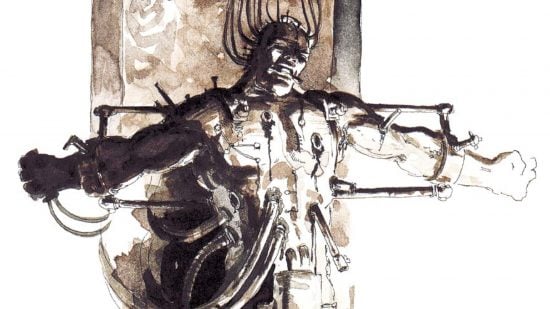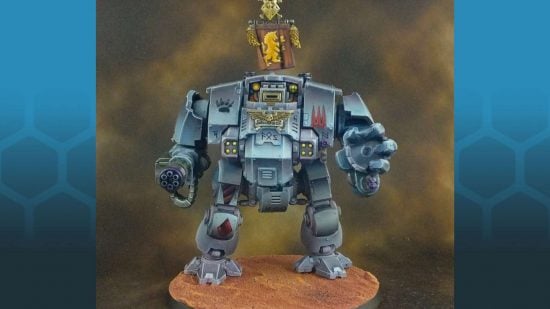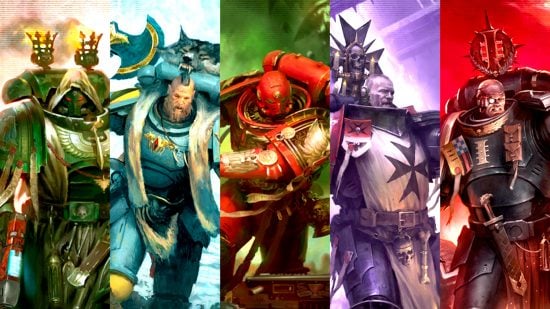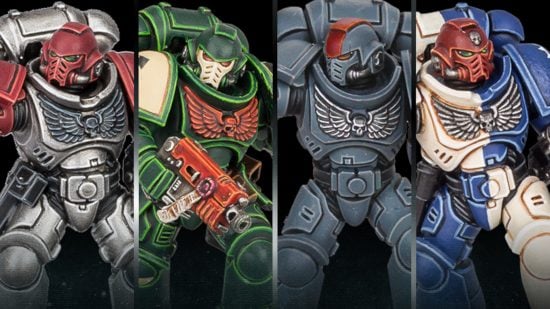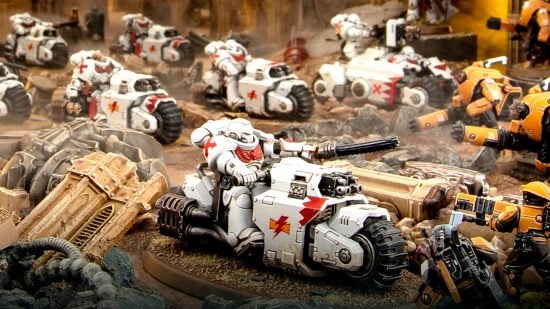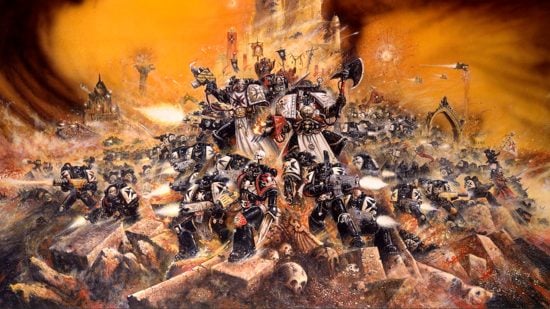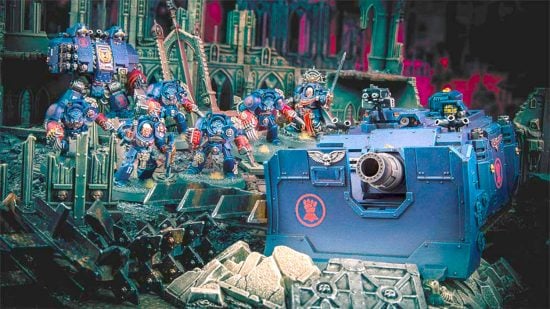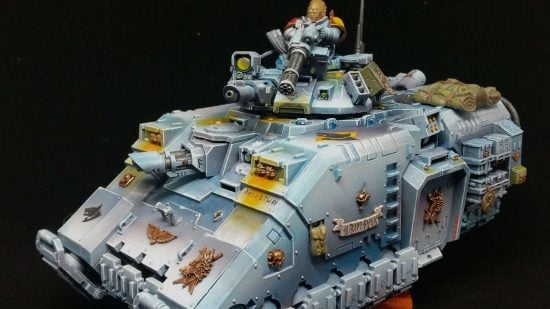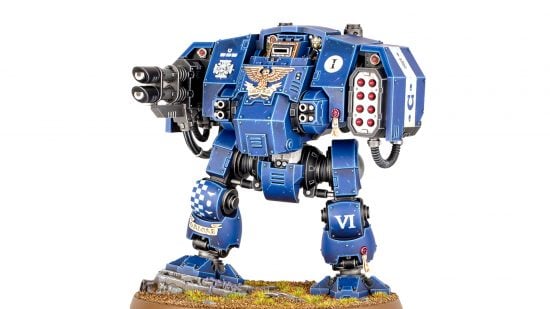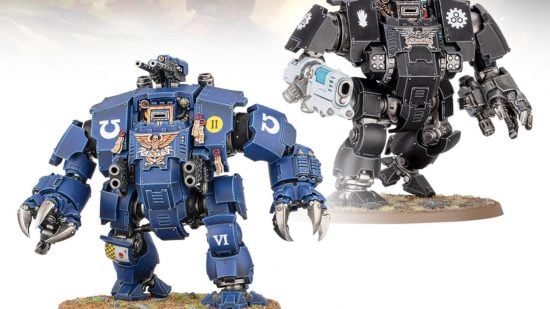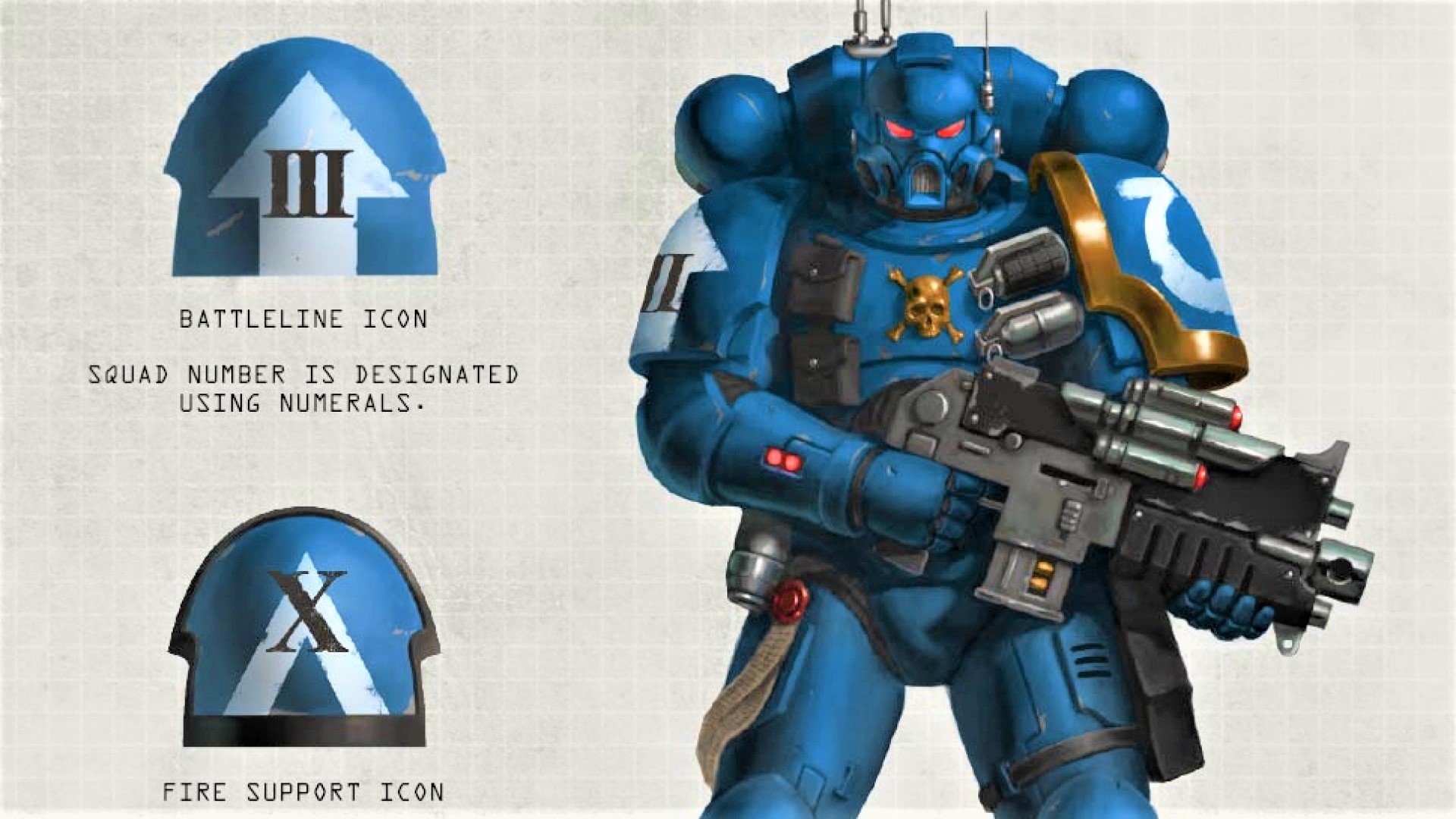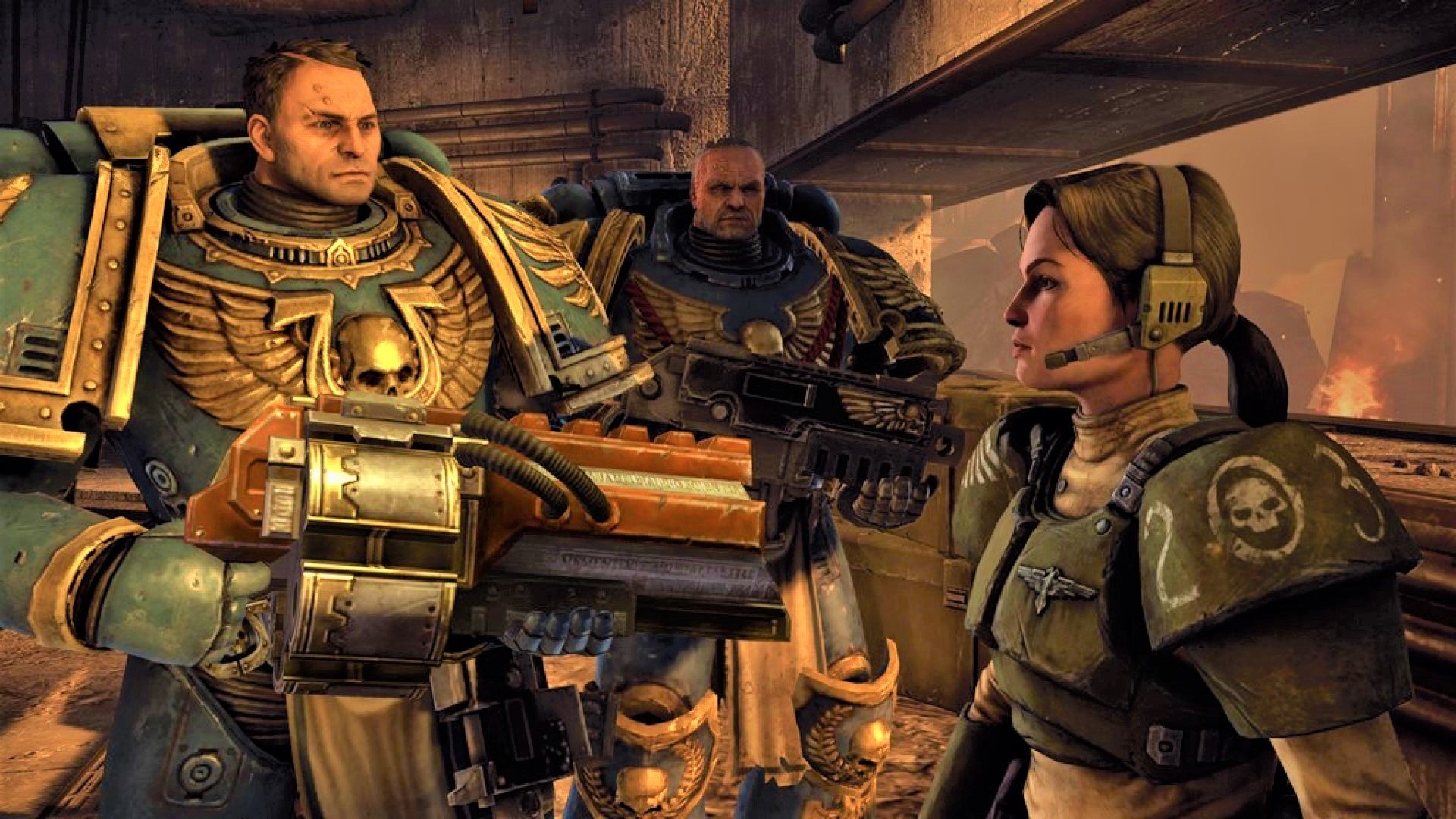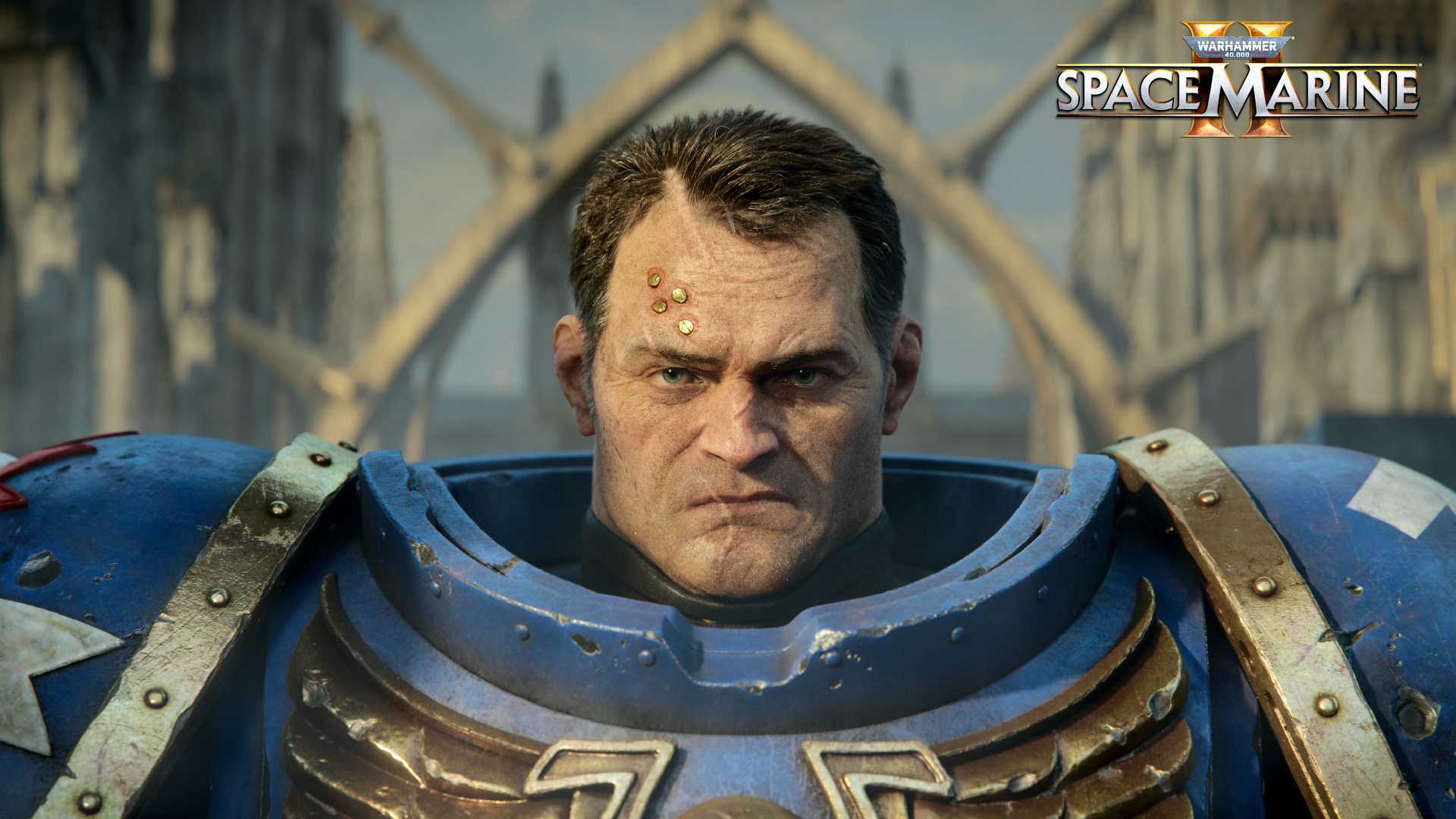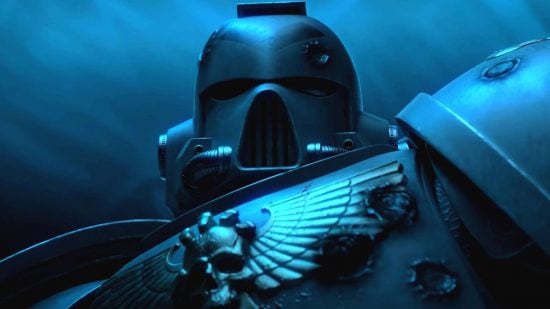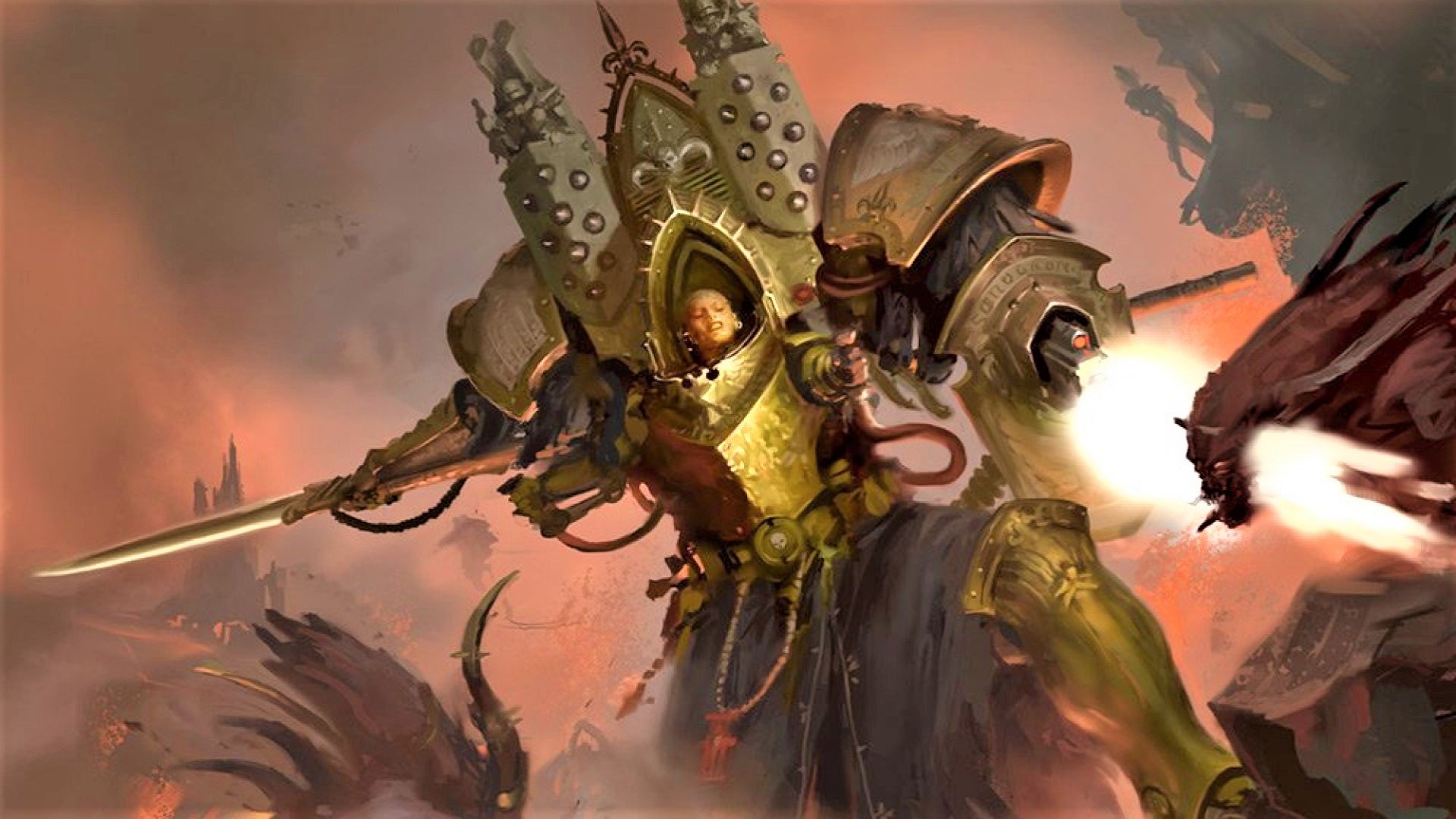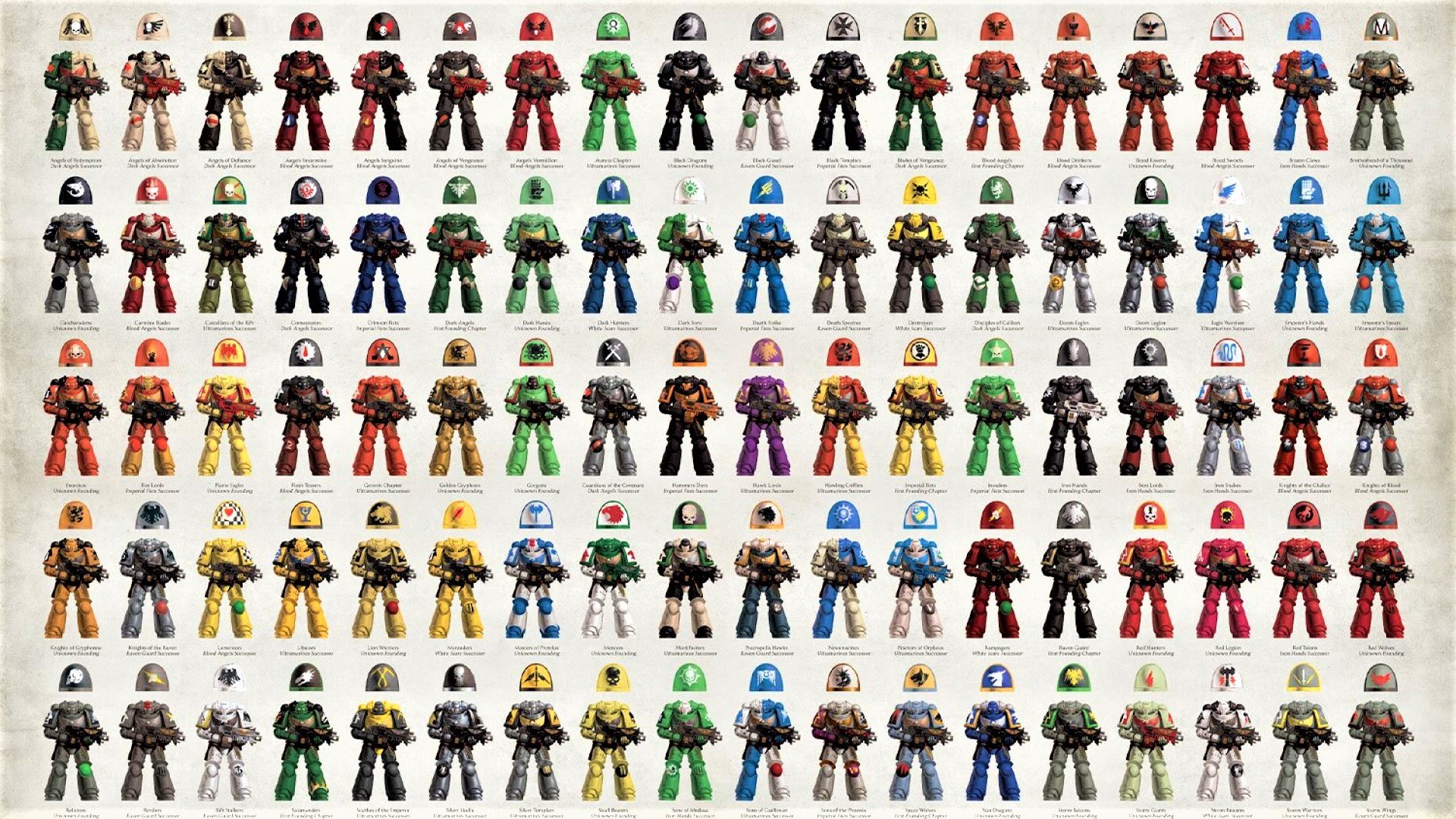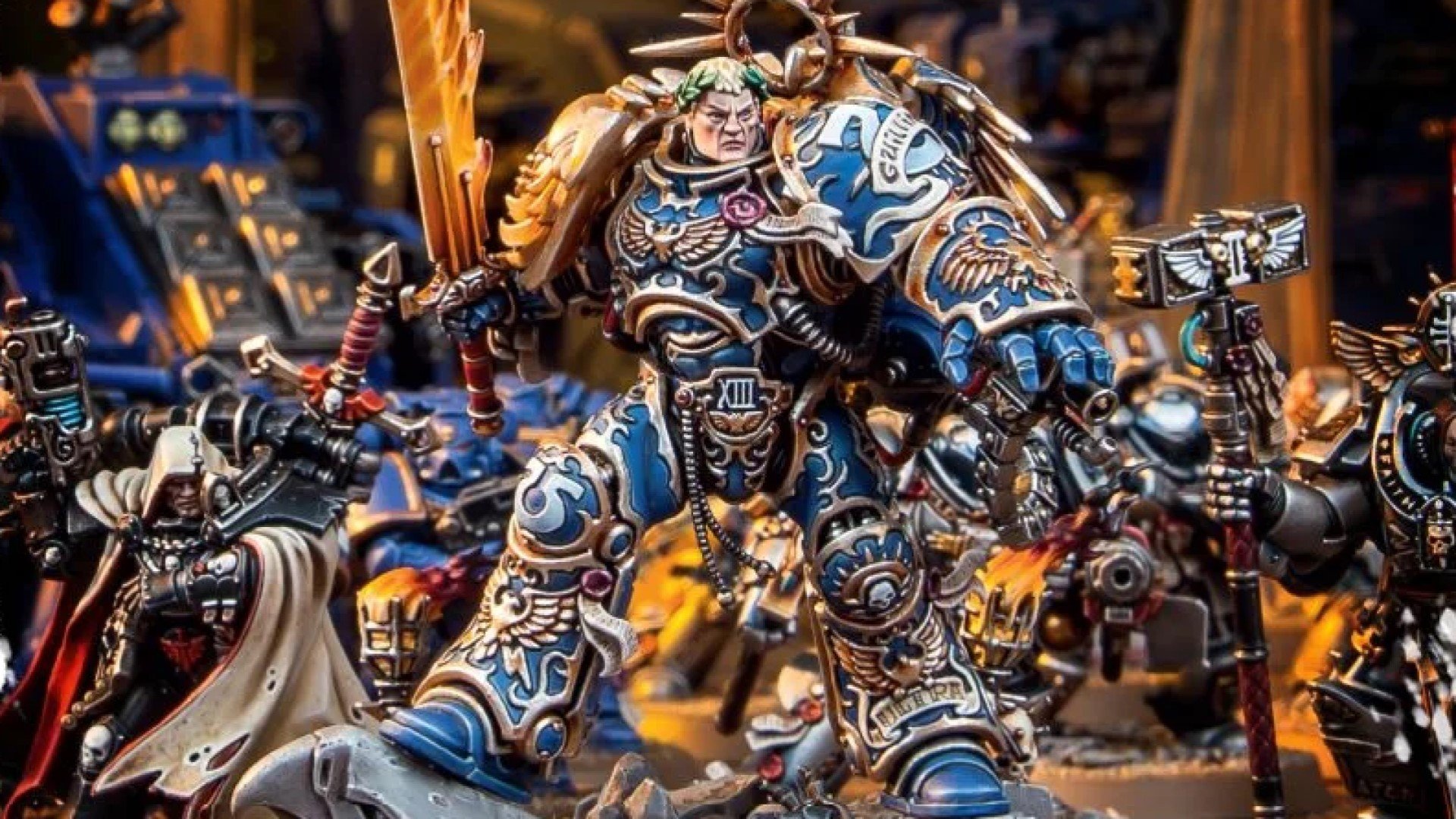Warhammer 40k Space Marines are the most famous, popular, and prominent army in Games Workshop’s sci-fi tabletop game. The power-armored super-soldiers of the Adeptus Astartes are a perpetual favourite on the tabletop, supported by a vast range of miniatures. This guide explains their lore, how to find great deals on Space Marine models, and what you need to know to keep up to date with their rules.
The chances are you’ve seen at least one Space Marine before; they’ve been the public face (or rather faceplate) of Warhammer 40k since its inception in 1987, and they’re by far the most popular Warhammer 40k faction in the tabletop wargame.
There’s so much to say about the Space Marines that this guide alone doesn’t cover them. We have a separate guide about the Space Marine Chapters and legions that explains the many different monastic brotherhoods that the Space Marines are divided between. Our guide on how to paint Space Marines explains the process of painting Space Marine models for a complete beginner.
Here’s everything you need to know about Warhammer 40k Space Marines:
- What are Space Marines?
- Where to buy Space Marine deals
- Space Marine Chapters
- Primaris Space Marines
- Space Marines Dreadnoughts
- Vanguard Space Marines
- What are Space Marine Terminators?
- Space Marine games, books, and movies
- Are there female Space Marines?
- Space Marine color schemes
- What are the Space Marines army rules?

What are Space Marines?
Space Marines – also known as the Adeptus Astartes – are surgically enhanced, mentally indoctrinated super-soldiers, who wield the most powerful arms and armor available to the Imperium of Man. They are fanatically loyal to the Emperor of Mankind – trans-human special forces created to the Emperor’s own arcane design – and it’s their job to fight his deadliest enemies, at the sharp end of all humanity’s wars.
Each Space Marine begins life as a human adolescent, and is selected to enter a chapter through a series of gruelling trials. Those who survive receive a series of genetically-engineered implants, or “geneseed”. Some are additional organs, like the third lung and second heart, while others alter their metabolism and enable the other implants to function – read our guide on the Space Marine organs to find out what they all do!
The final implant, the black carapace, allows the neophyte to wear Space Marine armor. Via the black carapace, a Space Marine can form a direct mental bond with their power armor, affording them complete control over this strength-enhancing mechanical exoskeleton.
Even without their bulletproof ceramite plate, however, Space Marines’ artificial organs and ‘gen-hanced’ transhuman physiology makes them functionally immortal, immune to all natural disease, able to survive grievous wounds, and gifted with a bevy of superhuman abilities.
Space Marines are heavily indoctrinated with psycho-conditioning. This ensures their loyalty to the Emperor – for the threat of a Space Marine slipping their mental bonds and succumbing to the Warhammer 40k Chaos powers is too great to be ignored (read our Chaos Space Marines guide for more info).
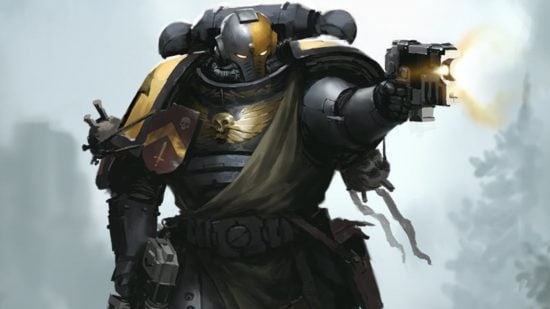
Adeptus Astartes warriors may go to battle in any one of myriad different configurations and loadouts, kitted out for various specialised battlefield missions. Spaceship boarding, stealth assassinations, crowd control, massed assaults, armored blitzkrieg – you name it, Space Marines can do it.
Almost all chapters start out their new recruits as lightly-armored scouts – but, once they graduate from that role (after a few decades in the field, usually), marines are re-equipped and redeployed in any one of countless units, from standard line soldiers and jump-pack shock troops, to expert vehicle crews, to the fearsome, elite Space Marine Terminators.

Where to buy Space Marine deals
The best source for Space Marine deals is the second hand market. Because Space Marines are so popular, included in every Warhammer 40k Starter Set, and are often a new player’s first army, there are more Space Marines available to purchase second hand than any other army.
A great first place to look for secnod-hand minis is eBay. Not only is it possible to snag a bargain or a big bundle of bits, it provides buyer protection on your purchases.
There are many Warhammer 40k trading groups on Facebook. While there are bargains to be had, beware scammers. Ensure any payments you make have buyer protection: use the “pay for goods and services” option if you use PayPal, not “friends and family”, for example.
Typically, expect to pay more per item to buy specific, unbuilt kits, and less per item for bundle deals and built and painted models (particularly if they’re badly painted).
It’s possible to remove paint from models by soaking them in isopropyl alcohol (rubbing alcohol), Simple Green (in the USA) or Biostrip 20 (in the UK), then scrubbing the paint off with a cheap toothbrush. Wear cleaning gloves to protect your skin. If you’re under 16, get an adult’s help.
We recommend an ultrasonic cleaning bath as a great hobby tool to aid with this. Be careful when stripping resin miniatures, as they can only survive a very brief immersion in solvents.
If you’re looking for cheaper first-hand Space Marine models, most local game stores and online retailers sell them at a discount compared to Games Workshop’s official webstore. GW also produces bundles of figures which are also discounted.
Space Marines Combat Patrol
The three Space Marines Combat Patrol starter boxes all provide a good value bundle of models, costing $160 USD / £95 GBP on the official GW webstore (and cheaper elsewhere) and containing a small starter army.
The Combat Patrols for the Space Wolves, Dark Angels, Blood Angels, and Deathwatch all contain models you can use in any Space Marine army, plus upgrade sprues with chapter specific bits. There’s also a Black Templars combat patrol, though this contains models only that Chapter can field in games.
Combat Patrols are small self-contained armies which you can use as the basis of an army, to expand a collection, or in the beginner-friendly Combat Patrol game mode. The Space Marine half of the ‘ultimate edition’ Warhammer 40k Starter Set can also be used in this game mode.
You may also find a slightly older Combat Patrol Space Marines box, containing Vanguard Space Marines, in your friendly local game store. This doesn’t have rules for Combat Patrol in 10th edition, but it’s a great start to an army.
Space Marine Chapters
In the 41st millennium (and, per the current lore, the opening years of the 42nd) the Space Marines are organised into a number of distinct, independent fighting forces known as Space Marine Chapters.
We have a whole guide dedicated to explaining the many Space Marine Chapters – and the ancient Space Marines Legions that preceded them – so for the full story, click that link. For now, we’ll provide an overview of what they are, how they operate, and name a few of the most prominent chapters at large in the 40k universe.
A Space Marine chapter is a discrete, organised fighting force of Adeptus Astartes warriors, with its own proud name, history, color scheme, symbology, and heraldry. It’s usually led by a single Chapter Master and, beneath them, split into multiple units (normally called companies) commanded by senior officers. Most chapters contain a nominal 1,000 Space Marines.
Most chapters keep their own fleets of void-borne warships and armories of weapons, munitions, and Warhammer 40k tanks – all maintained with the assistance of allied tech-priests from the Adeptus Mechanicus, whose hallowed task it is to keep all Imperial technology in working order.
Beyond that core definition, chapters often differ wildly from each other, in terms of their numbers; their philosophies and priorities; their power structures and organisation; and especially in their preferred weaponry and ways of war.
Space Marine chapters may protect a region of Imperial space based around their home-world, or they may travel the galaxy on mighty crusades to drive back the Xenos races and forces of Chaos that threaten mankind. Many chapters have no home-world, instead maintaining a base of operations in a mobile fortress monastery ship.
Chapters even diverge from one another at the level of basic genetic makeup. Every chapter officially claims its genetic heritage from the gene-seed of one of the original Warhammer 40k primarchs. But, after 10,000 years of warfare, losses, reinforcements, and extremely shoddy record-keeping, it’s more or less impossible to be sure how true those claims are any more. That’s doubly true for the new Primaris marines (more on them later).
There are thought to be 1,000 chapters in the Imperium of Man, each numbering around 1,000 marines. If that’s true, then there’s at least one Space Marine for every world in the Imperium – but in reality there are almost certainly far more than that.
What is the Codex Astartes?
The Space Marine Chapters were originally created according to the Codex Astartes, a war manual written by Ultramarines primarch Roboute Guilliman which formally limited the size of each Space Marine army to 1,000. This, he hoped, would prevent any one Astartes force from becoming too powerful and turning against the Imperium, as happened in the disastrous Horus Heresy era, when Space Marine legions united tens of thousands of Astartes under one banner.
But, while many so-called ‘codex compliant’ chapters still follow these restrictions in the 41st millennium, a significant number definitely don’t – including the Black Templars and Space Wolves, both of whom use their decentralised command structures as an excuse for maintaining forces of many thousands of marines at all times.
You can learn more about the Codex Astartes in our dedicated Codex Astartes guide.
What are the most important Space Marine chapters?
Out of the roughly 1,000 chapters waging war across the galaxy, only a couple of dozen are well known to us, enjoying prominence in Games Workshop’s novels, lore texts, videogames, and other media, as well as their own unique, named characters and miniatures.
Chief among these are the so-called First Founding chapters – those which were formed directly from the original loyalist Space Marine legions, seven years after the Horus Heresy ended, and kept their former names, colors, insignia, and genetic code.
The First Founding chapters are:
| Chapter name | Chapter Master (or equivalent) |
| Dark Angels | Supreme Grand Master Azrael |
| White Scars | Great Khan Jubal Khan |
| Space Wolves | Great Wolf Logan Grimnar |
| Imperial Fists | Gregor Dessian |
| Blood Angels | Commander Dante |
| Iron Hands | None (led by an elected Iron Council) |
| Ultramarines | Marneus Calgar |
| Salamanders | Regent of Prometheus Tu’Shan |
| Raven Guard | Master of Shadows Kayvaan Shrike |
Also among the ranks of the famous are a few successor chapters – a generic name for all other chapters. It’s helpful to split these into two categories:
- Second Founding chapters – formed from the rest of the dissolved legions, at the same time as the nine core, First Founding chapters.
- Other chapters – the many hundreds of new chapters founded over the following 10,000 years (plus a few special cases).
The most prominent successor chapters are:
| Chapter name | Chapter Master (or equivalent) | Successor of |
| Black Templars | High Marshal Helbrecht | Imperial Fists |
| Crimson Fists | Pedro Kantor | Imperial Fists |
| Flesh Tearers | Gabriel Seth | Blood Angels |
| Lamenters | Malakim Phoros | Blood Angels |
| Emperor’s Spears | High King Arucatas | Ultramarines |
| Fulminators | Unknown | Ultramarines |
| Hawk Lords | Unknown | Ultramarines |
| Novamarines | Bardan Dovaro | Ultramarines |
| White Consuls | Ridian Artemanis | Ultramarines |
| Carcharodons | Shade Lord Tyberos ‘The Red Wake’ | Raven Guard (unconfirmed) |
| Raptors | Lias Issodon | Raven Guard |
| Blood Ravens | Gabriel Angelos | Unknown |
| Minotaurs | Asterion Moloc | Unknown |
Primaris Space Marines
The Primaris Space Marines are the pinnacle of transhuman soldiery, a more physically advanced, better equipped, upgraded version of the Space Marines, engineered over ten millennia by Archmagos Dominus Belisarius Cawl – an ingenious, eccentric, and decidedly dangerous senior Tech-priest of the Adeptus Mechanicus.
Introduced to the tabletop game and the fiction at the same time, with the launch of Warhammer 40k’s 8th Edition in 2017, the Primaris Space Marines started off with a small selection of up-scaled Space Marine characters and units that joined the original ‘Firstborn’ Marines. As of 2024, they’re gradually replacing the original marines entirely.
Taller, stronger, and faster than the original Adeptus Astartes, clad in upgraded Mark X power armor, and equipped with a whole range of superior wargear, the Primaris marines do all the same things as their forebears – only better. In the lore, at least. In 10th edition, Primaris and old-style ‘Firstborn’ marines fill different battlefield roles, but have similar stats.

Almost all the Space Marine Chapters have received large influxes of Primaris Space Marine reinforcements. These have either been delivered in person via Roboute Guilliman’s Indomitus Crusade, or by Torchbearer fleets of the Adeptus Custodes transferring the secrets of their creation. Where Primaris and Firstborn have suddenly begun thrust together, friction, distrust, and culture shock have resulted.
Entire new Space Marine Chapters, such as the Fulminators and Rift Stalkers, have been formed entirely of Primaris marines, in the so-called Ultima Founding, ordered by Roboute Guilliman.
Even prominent leaders among the Firstborn Space Marines have undergone arcane and painful surgery to be converted into Primaris marines – led by Ultramarines Chapter Master Marneus Calgar, and followed by many others, including the Black Templars’ High Marshal Helbrecht.
The burning question – both on the tabletop, and canonically in Warhammer 40k lore – is: are the Firstborn marines on the way out? Will the new and improved Primaris breed entirely replace the original Adeptus Astartes that have held firm in defence of the Imperium of Man for 10,000 years? It certainly looks that way.
Primaris Space Marine units
| Unit | Armament | Armor |
| Intercessors | Boltrifles and variants | Tacticus |
| Heavy intercessors | Heavy boltrifles and variants | Gravis |
| Assault intercessors | Heavy bolt pistol and astartes chainsword | Tacticus |
| Hellblasters | Plasma incinerators and variants | Tacticus |
| Aggressors | Boltstorm gauntlets or flamestorm gauntlets | Gravis |
| Inceptors | Paired assault bolters or plasma exterminators | Gravis |
| Eradicators | Melta rifles or heavy melta rifles | Tacticus |
| Bladeguard Veterans | Mastercrafted power swords and storm shields | Tacticus |
| Desolation squad | Indirect-fire castellan launchers, plus superkrak or superfrag missiles | Tacticus |
| Jump Pack Intercessors | Heavy bolt pistol and astartes chainsword | Tacticus |
| Sternguard Veteran Squad | Combi-bolters, Sternguard boltrifle, heavy bolter or pyrecannon | Tacticus |
| Infernus squad | Pyreblasters | Tacticus |
Primaris Space Marine vehicles
| Vehicle | Chassis | Role |
| Redemptor Dreadnought | Redemptor | General support walker |
| Brutalis Dreadnought | Redemptor, up-armored | Front-line melee walker |
| Ballistus Dreadnought | Redemptor | Fire support walker |
| Repulsor | Repulsor | Heavy troops carrier and support weapon platform |
| Impulsor | Impulsor | Light troops carrier |
| Repulsor Executioner | Repulsor | Heavy tank with limited APC capability |
| Storm Speeder Hailstrike | Storm Speeder | Mobile anti-infantry platform |
| Storm Speeder Thunderstrike | Storm Speeder | Mobile heavy fire platform |
| Storm Speeder Hammerstrike | Storm Speeder | Mobile anti-tank |
| Gladiator Lancer | Impulsor | Light long-ranged tank-hunter |
| Gladiator Reaper | Impulsor | Light anti-infantry |
| Gladiator Valiant | Impulsor | Light short-ranged tank-hunter |
| Invader ATV | Invader | Ultra-light mobile fire support |
| Invictor Tactical Warsuit | Stripped back Redemptor | Mobile fire support with infiltration capability |
Space Marine Dreadnoughts
No guide to the Adeptus Astartes would be complete without introducing you to their grumpy grandpas: the hulking, heavily armored, walking death machines that are Space Marine Dreadnoughts.
When the heroes of a Space Marine chapter become grievously wounded and beyond ordinary medical help, they are sometimes converted into Dreadnoughts: enormous, two-legged walking weapons platforms encased in thick armor, controlled by the dying warrior’s brain – which remains preserved in a shielded, fluid-filled golden casket at its heart.
It’s a grim existence for these fallen warriors, filled with phantom pains and existential dread, all too aware that they have no body, but live indefinitely in an unfeeling tank of cold iron. As a result, for the good of their own sanity, Dreadnoughts are normally kept in hypnotic stasis until they are awakened for war in times of special need.
Many models of Astartes Dreadnoughts have seen war service over the millennia, fitted with all manner of different armaments to fulfil different battlefield roles, from long-range tank-killing guns to stone-cutting siege drills.
What unites them all is resilience and versatility: Dreadnoughts aren’t as fast as tanks, or as flexible as infantry – but they’re tough as nails and can be loaded up to dish out huge damage both at range and in close combat. Woe betide any enemy that lets their giant motorised fists get in range.
For more on them, read our complete Space Marine Dreadnoughts guide.
Vanguard Space Marines
The Vanguard Space Marines – sometimes also referred to as Phobos marines – are a specialised sub-set of the Primaris Space Marines, kitted out for covert operations, stealth, sabotage, and reconnaissance. They were introduced to both the tabletop game and Warhammer 40k lore in the 2019 Shadowspear box set.
Vanguard Space Marines wear a modified version of the standard Primaris Mark X power armor, designated ‘Phobos’ pattern, which appears slightly lightened and streamlined, with smaller, less angular shoulder pads for ease of mobility. As advance recon troops expected to operate independently for long periods, Vanguard Space Marine units also tend to carry more supply pouches and grenades, and more sophisticated comms equipment than the average line Astartes.
In games, Phobos plate has the same basic stats as the regular, Tacticus-Pattern armor, but makes the wearers eligible for other stealth-related abilities and rules.
Probably the most popular Vanguard Space Marine units have been the Infiltrators and Incursors – specialized infantry squads offering alternatives to your vanilla Primaris Intercessors. Each offers its own added tactical advantages.

Prominent Vanguard Space Marine units include:
What are Space Marine Terminators?
Space Marine Terminators are elite warriors clad in Tactical Dreadnought Armor, aka Terminator Armor. This is the most advanced personal protective wargear available to the Imperium of Man. It incorporates both heavy duty armor plating, and powerful forcefield generators, capable of deflecting enemy shots and
Each suit of Terminator armor is a holy relic to the chapter that possesses it, for the knowledge of their manufacature is almost entirely lost. Only the elite of a chapter, usually its first company veterans and command staff, has the rite to bear this incredible panoply to war.
You can learn more about this awesome wargear in our Space Marine Terminators guide.
Space Marine games, books, and movies
The Warhammer 40,000: Space Marine game, released in 2011 by publisher THQ and developer Relic Entertainment, is very possibly the best Warhammer 40k game ever made, for PC or games consoles.
It’s a videogame that focuses almost all its energy on the audio-visual rhythm and sheer serotonin-pumping, kinetic joy of its combat gameplay – and fills in the piffling details of story, characters, environments, level design, and other such distractions, afterwards.
Stepping into the ceramite boots of Ultramarines Captain Titus, you’ll lead your squad through the Ork-infested factories and streets of an embattled Adeptus Mechanicus Forge World, and along the way uncover a nefarious Warp plot hatched by a Chaos Space Marine sorcerer.
If you haven’t played it, why not? You’ve had a decade! Go and play it after reading this. There’s even a brand new Anniversary Edition now, rolling in all the DLC packs and a bunch of extras – so you really have no excuse.
Space Marine 2
What’s more, there’s now a sequel – Space Marine 2 – on the way! Check out our running guide to keep up-to-date with the Space Marine 2 release date; we’re also collating a Space Marine 2 walkthrough with more details, as they emerge.
Books about Space Marines
Games Workshop’s Fiction publishing arm Black Library publishes more books about Space Marine than almost any other topic. Our guide to the best Warhammer 40k books has some recommendations.
Astartes Animation
Independent animator Syama Pedersen created the incredible Warhammer 40k fan animation Astartes single-handed, releasing it to YouTube. When Games Workshop launched its own Warhammer animation studio and streaming service Warhammer+, it hired Pedersen to join the team there. If you have a My Warhammer account, you can watch Astartes on Warhammer+ whether or not you’re a subscriber to the service.
Warhammer Plus Space Marine animations
There are several original animations on Games Workshop’s Warhammer TV streaming service starring Space Marines. We have another guide, examining whether the Warhammer+ subscription you need to see those animations is worth the price.
Are there Female Space Marines?
There aren’t any female Space Marines. The reasons why, both within the lore and in terms of the history of the Warhammer 40k product range, are suprisingly convoluted. We have a dedicated guide to female Space Marines explaining it all.
Space Marine color schemes
As the photo above should demonstrate, there are effectively unlimited ways you can paint Space Marines. GW’s vast library of lore has fleshed out colors, insignia, and varying amounts of narrative detail for several dozen of Space Marine chapters – and if one of these catches your eye, go for it
We go into picking Space Marine color schemes in more detail in our guide on how to paint Space Marines.
What are the Space Marine army rules?
The full Space Marine army rules can be found in the Codex: Space Marines army supplement. This supercedes the Index: Space Marines that Games Workshop published with the launch of 10th edition 40k.
All Space Marines benefit from the Oath of Moment keyword. This is a solemn vow that the Astartes swear before they embark on a mission – in the wargame it provides a simple and powerful buff. At the start of your Command phase you pick a single enemy unit, and until your next Command phase your entire army will be able to re-roll when rolling to hit or to wound that unit.
The Space Marine Codex contains eight Detachments, each of which gives your army access to a unique detachment rule, six Stratagems, and several optional unit Enhancements. The Gladius Task Force Detachment is a generalist army that supports most Space Marine units equally, while the others are all focused around a particular theory of war and subset of units.
Can you mix Chapters in a Space Marine army?
You can’t mix Chapters in a Space Marine army. Some Space Marine units have an additional faction keyword that indicates the Space Marine Chapter they’re drawn from, and your army can’t contain more than one such chapter keyword.
All the Detachments in the Space Marines Codex are available to all Space Marine Chapters. However, Detachments found in a Codex supplement or Index supplement, such as the Inner Circle Taskforce in Codex Dark Angels, may only contain units from that Chapter or units that don’t have any Chapter keyword.
Other than that, standard army building rules apply to Space Marines: you may include up to three copies of a single unit, or six if the unit has the Battleline keyword. As an Imperial army, Space Marines may be joined by Imperial Agents like 40k Assassins and the 40k Inquisition, or an Imperial Knight freeblade. This doesn’t interact with the rules for Chapters at all.
What’s in the current Space Marines FAQ and errata?
To make sure you’re up to date with Space Marines FAQ and errata, you need three documents from the Warhammer Community website:
The Field Manual has the latest points values for the Space Marines, superseding those in the Codex. The Errata fixes three minor printing errors in Codex Space Marines, which change:
- The wording of the Ancient Fury Stratagem in the Ironstorm Spearhead Detachment
- Which units Kor’sarro Khan can lead
- The wording of the Ardent Protectors battle honor from the Chapter Command campaign rules
The Balance Dataslate affects the rules for Space Marines in Matched Play, as well as making some core rules changes. The April 2024 Balance Dataslate limits the size of Desolation Marines squads to one sergeant and four models. There are further changes for the Space Wolves and Blood Angels chapters.
The April 2024 Balance Dataslate makes some important core rules changes too. Abilities that allow a unit to use a Stratagem for 0CP, or that allow them to use a Stratagem that another unit has already used, may only affect Battle Tactic Stratagems. That includes the Space Marine Captain’s ‘Rites of Battle’ ability.
After 30 years, Space Marines are still the go-to army for most newcomers to Warhammer 40k, and with good reason – we can confidently recommend them as a way into the game and hobby alike. If you’re teetering on the edge of starting a Demi-Company of your own, we’d say go for it, don’t be afraid. You’re about to become one of the Emperor’s Angels of Death, after all – And They Shall Know No Fear.
With thanks to Nerodine for his Space Wolves Redemptor Dreadnought, and Repulsor.
